Austin Migration Insights
Sign up for the Central Texas Economy Report newsletter
Posted on 03/04/2020 by Chris Ramser
- Annually since 2010, the Austin metro area gains about 30,800 people a year from domestic migration, 7,300 from international migration, and 16,500 from natural increase.
- Austin ranks first among the top 50 largest metros for new residents as a percent of total population.
- The greatest source of new migrants to the Austin metro is other parts of Texas.
- The most significant metro area net contributors to Austin MSA’s annual growth are Houston, Dallas, San Antonio, New York, and Los Angeles.
Census Day[1] is less than a month away and an accurate count of our population is vital to ensure our region receives a fair share of federal funding, congressional representation, and more. Over the last decade, Texas has, by far, added the most population of any state, and Austin is the fastest growing large metro. With Austin’s rapid growth, due to high levels of domestic migration and increasing international migration, the region is dependent on residents responding and insuring our population count is as complete as possible.
Population estimates & net migration
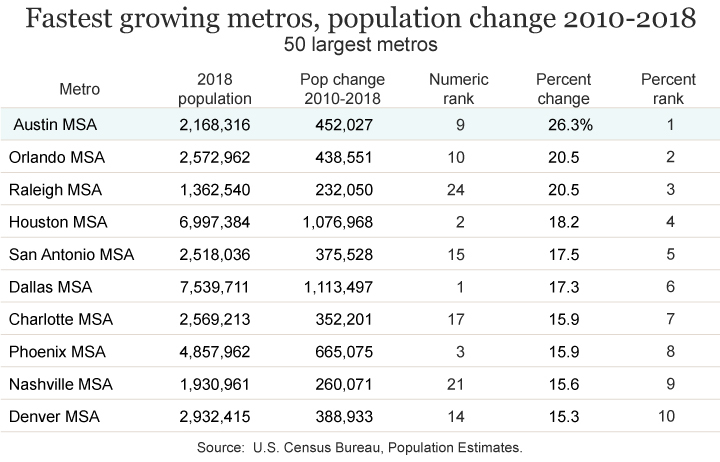
Since the beginning of the decade, the Austin MSA has grown by an average of 55,100 people annually, according to the U.S. Census Bureau’s population estimate program. Much of this growth is attributable to domestic migration, roughly 55.8%, with another 13.2% due to international migration, and 29.4% from natural increase. From 2010 to 2018, the region received a net gain of about 30,800 people annually from other locations in the U.S.

Austin ranks first among the top 50 largest metros for having the greatest share of our total population as new residents. Between 2010 and 2018, Austin added 310,931 net new migrants, or 14.3% of our total 2018 population. Orlando came in second with 13.4% and Raleigh was third with 11.7% of their current population attributed to net new residents. Two other Texas metros also made the Top 10—San Antonio ranked 6th and Dallas was 10thwith 9.5% and 8.5%, respectively.
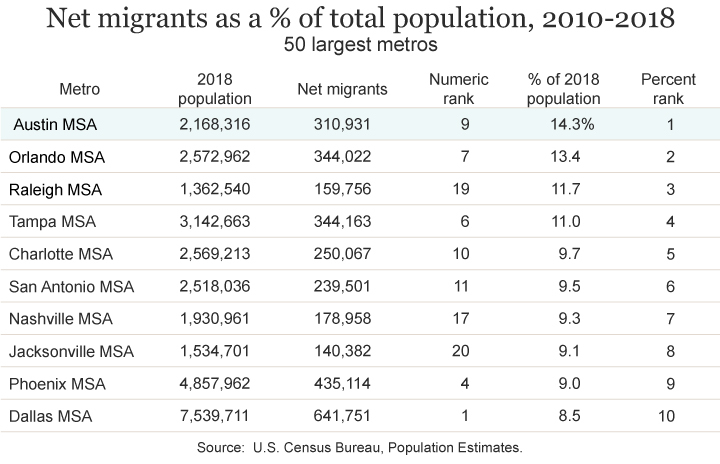
While domestic migration is the predominate share of migration for Austin, some metros rely mostly on international migration including Miami, San Jose, New York, Washington, Boston, San Francisco. Several metros would have negative migration but for the infusion of international migrants. Austin was 15th out of the 50 largest metros for international net migration as a percent of total population.

Texas’ growth is almost evenly divided between natural increase (births minus deaths) and net migration. Texas’ population change from 2017 to 2018 was 50.4% from natural increase and 49.5% from net migration, while Austin’s growth was 29.5% from natural increase and 70.1% from net migration.
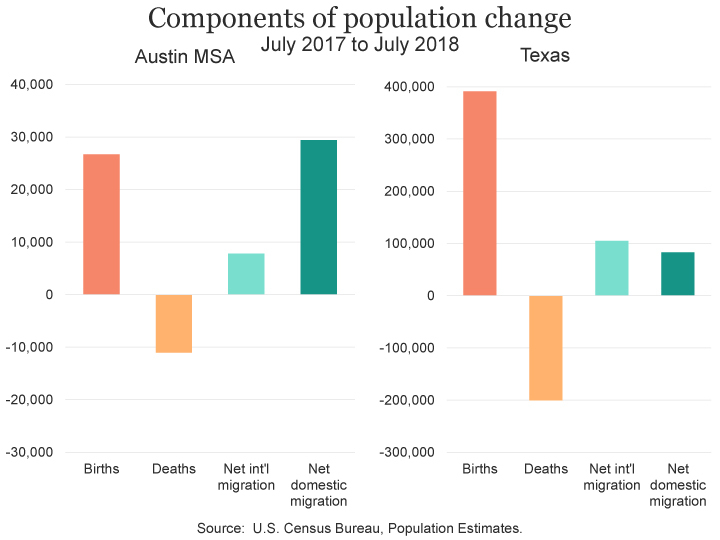
The region’s annual growth from 2017 to 2018, as calculated from the Census Bureau’s population estimates, was 53,086, or 145 persons per day. Of this daily number, net migration accounts for 102 and 43 are the result of births exceeding deaths.[2]
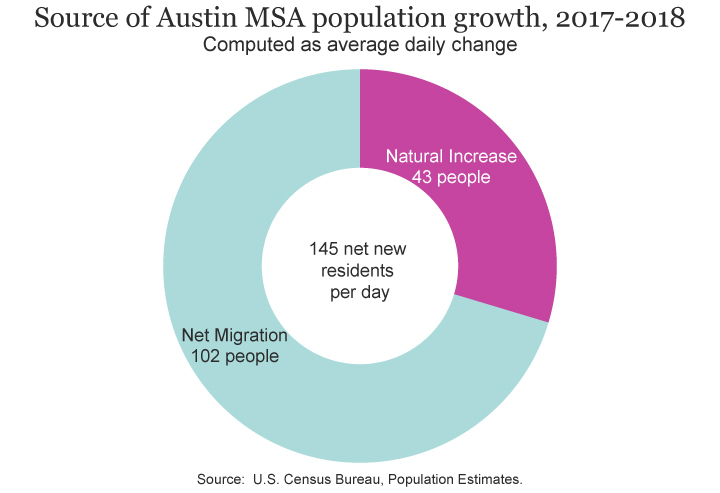
New 2019 population estimates for U.S. counties and metropolitan areas will be released in April 2020.
Geographic mobility
Additional insights into migration are provided by the Census Bureau’s American Community Survey (ACS). This annual sample survey, the replacement for the Decennial Census’s “long form” questionnaire, instituted following the 2000 Census, provides data on many demographic, economic, social, and housing characteristics of U.S. residents.
The ACS asks respondents questions about where they lived a year earlier. Of Austin’s 2,145,702 residents one year of age and older in 2018, 142,996 lived somewhere other than in the Austin MSA the year before. That’s 6.7% of Austin’s population and, among major metros, Austin ranks 3rd for “movers in” as a percent of total population.
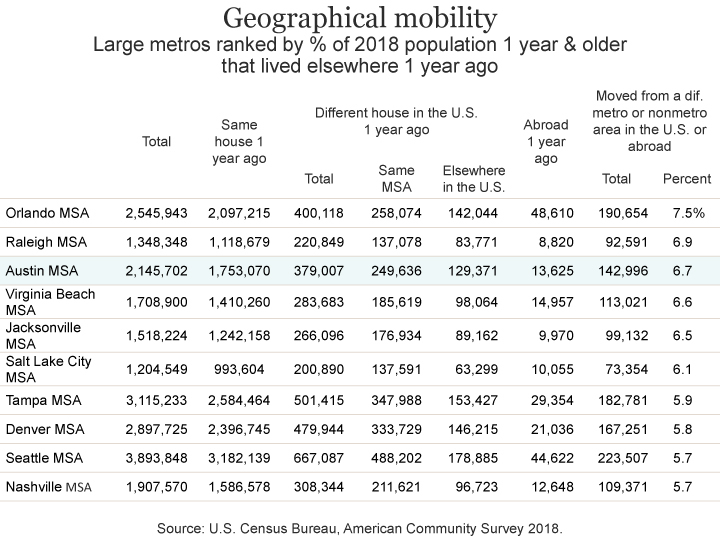
Origin of migrants
The ACS also provides detail on where people move from and move to. Using sample data collected each year, the Census Bureau aggregates 5 years of ACS data to generate estimates of annual migration between each U.S. county and publishes this data in its Census Flows Mapper application.[3] The current version of the map uses samples collected from 2013 to 2017 and estimates represent the annual number of movers during this period.
Data downloaded from Census Flows Mapper shows inbound and outbound flows, as well as net migrants, from a selected county to all other counties in the U.S. and Puerto Rico. Using the metro area aggregated tables, the Austin region received 117,804 domestic inbound migrants,[4] and sent 90,405 outbound migrants to other places, resulting in net migration of 27,399. Inbound flow was dominated by people arriving from other counties in Texas (52.8%), followed by California (7.0%), Florida (3.3%), New York (3.3%), and Illinois (2.4%). Each state that contributed at least 1.0% of inbound migrants to Austin MSA are labeled in the pie chart below. All other states contributed 14.4% of the inbound total.
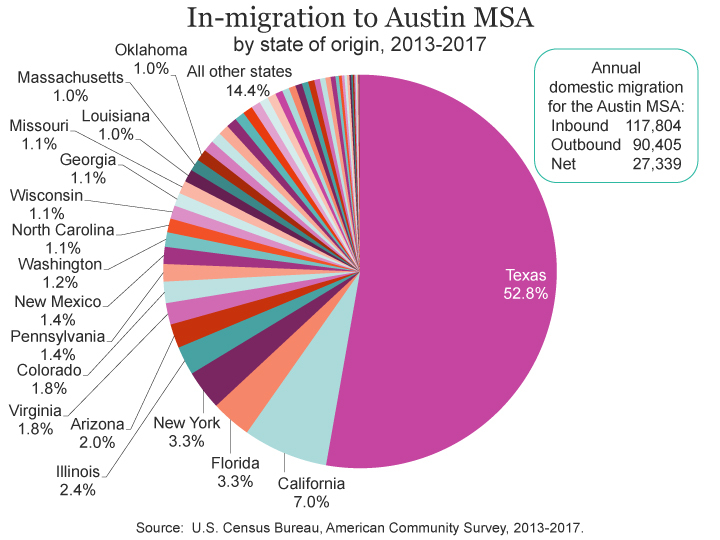
In-migration to the Austin region exceeded out-migration for 36 states, while Austin saw slight deficit flows with 15 states and the District of Columbia—that is, more Austinites departing to than coming from these states. Four states, excluding Texas with 11,638, contributed over 1,000 net migrants each to Austin, including California (3,686), New York (1,932), Illinois (1,191), and New Mexico (1,159) with another nine states contributing over 500 net migrants a year (Florida, 998; Virginia, 891; Arizona, 851; Wisconsin, 840; Pennsylvania, 653; Ohio, 634; Massachusetts, 624; New Jersey, 601; and Missouri, 548). The states that gained the most residents from Austin were Oregon (-590), Washington (-570), and Colorado (-439). Since the information for this release is collected through a sample survey, it is possible that some of the states with smaller net migration totals could be within the margin of error for these estimates, meaning it is impossible to tell if the state’s net migration was actually a deficit or positive flow.
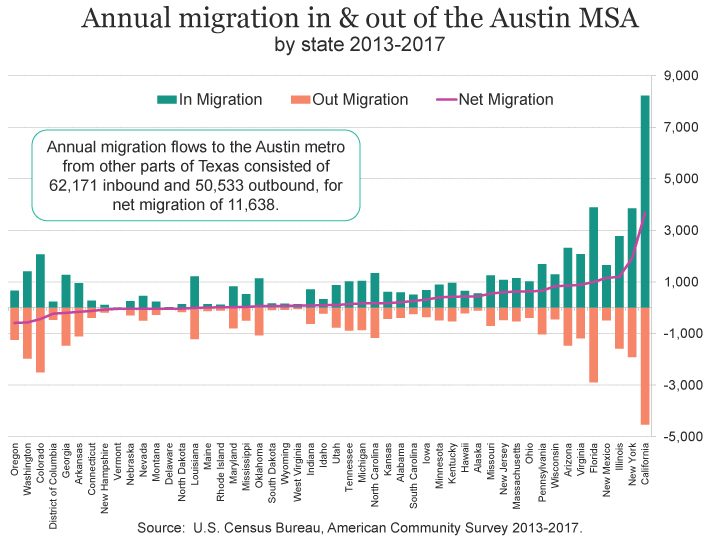
Net migration to the Austin region, while generally robust, has varied somewhat through the years depending on the economic conditions throughout the country. Five years ago (data collected from 2008-2012—around the time of the Great Recession), Austin saw an annual net migration from U.S. states at around 37,400 compared to 27,400 from the most recent release of data from 2013-2017. The top origin states for positive net migration five years ago were elsewhere in Texas, California, Florida, Illinois, Michigan and Arizona. Now, the states contributing the most gain to Austin still includes elsewhere in Texas, California and Illinois, but rounding out the list is New York and New Mexico. Migration from California, New York, Virginia, and Pennsylvania appears to have picked up over the last five years. The graph below shows a comparison of how the flow of the top states for contributing migrants has changed over the last five years.
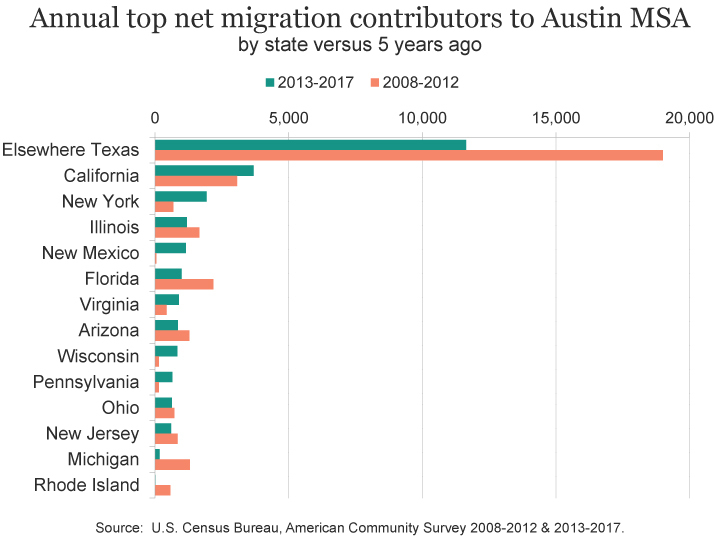
In addition to calculating total flows for the entire Austin metro, we’ve analyzed the migration flows between Austin and other metropolitan areas and produced two tables of the 20 largest positive and deficit flows. Of the top 20 net flows to Austin, eight were from fellow metro areas in Texas. Topping the list was Houston with a net 4,778 people to Austin each year over the past five years, followed by Dallas with 2,547, and San Antonio with 1,597. Rounding out the Top 5 were New York (1,553) and Los Angeles (1,424). Two other California metros (San Francisco, 733 and San Jose, 653), and two Arizona metros (Tucson, 560 and Phoenix, 438) were also in the Top 20. Counties that were not within a metro area sent an average net of 278 people each year to the Austin MSA over the past five years.
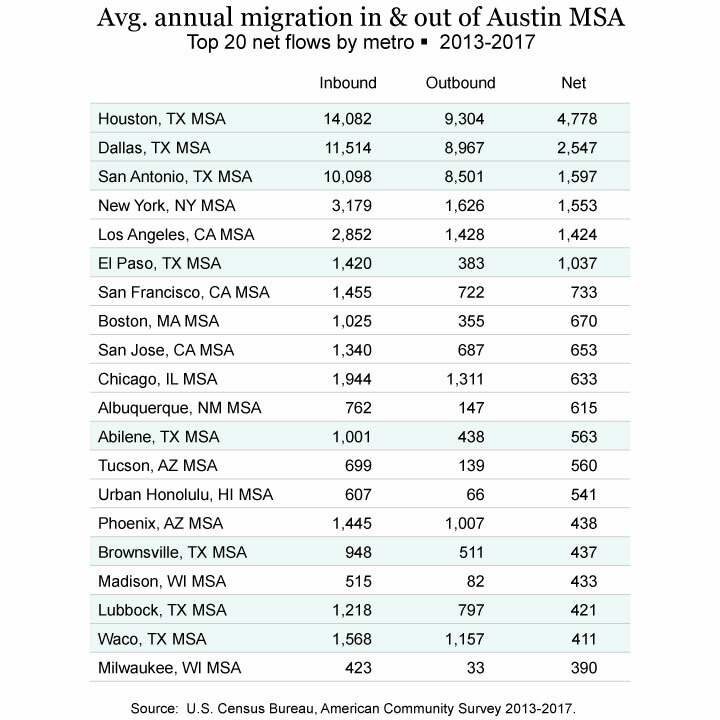
The top 20 metro areas with which Austin has a migration deficit included four Texas metros: College Station, Killeen, Longview, and Odessa. College Station was at the top of this list with an estimated annual inbound flow of 1,598 compared to outbound flow of 2,334 resulting in a net deficit of 736, while Killeen’s net deficit was 550. Rounding out the top five were Seattle with a deficit of 486, Denver at 478, and Portland at 401.[5]

Other metros with a large volume of in and outbound migrants but were not on the lists of the Top 20 net positive and deficit flows, were Corpus Christi (Inbound 1,618, outbound 1,542), Washington, DC (inbound 1,721, outbound 1,420), McAllen (inbound 1,312, outbound, 923), Miami (inbound 1,016, outbound, 646), and San Diego (inbound 869, outbound 538). Below is a choropleth map of the net annual migration to Austin for all metros. Areas in purple indicate metros with a deficit flow for Austin while the darker greens are the biggest net migrant contributors.
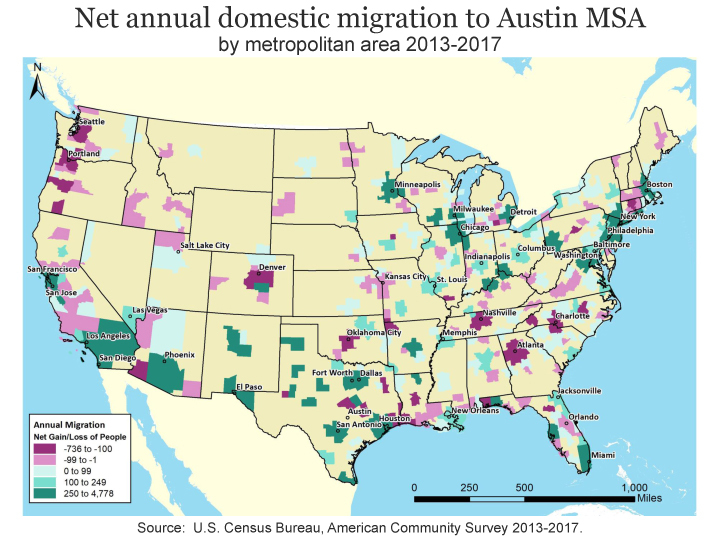
Analyzing migration between counties within the Austin area is also a possible use of this data. An annual estimate of 49,451 people moved from one county in the Austin metro to another. The below crosswalk table allows for looking up the total number of estimated movers from one metro county to another in the metro area. Start by picking a county from the vertical list of counties labeled “moved out of” and next pick a county from the list of horizontal list of “moved into” counties, finding the cell where the row and column intersection. For example, 18,026 moved out of Travis and into Williamson. Conversely, 10,439 moved out of Williamson and into Travis.
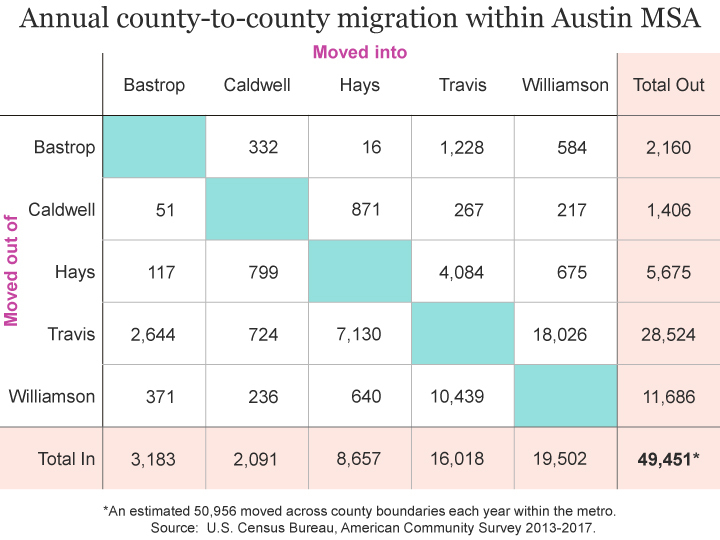
In addition to these migration data, the Internal Revenue Service (IRS) periodically publishes a dataset of U.S. migration data based on year-to-year address changes reported on individual income tax returns. The most recently available dataset is for 2017-18. The Capital of Texas Media Foundation has analyzed some of the trends from the IRS migration data files in this article.
To download an Excel workbook of several worksheets of the data presented in this article, click here. The file includes a summary table of county, metro, and flows for the Austin MSA region as well as an individual worksheet of county-to-county flows for each of the five Austin MSA counties.
FOOTNOTES:
- Census Day is April 1, 2020. By this date, all American households should receive an invitation to participate through the U.S. mail. Response can be completed online, by phone, or by mail and should reflect where your household lives as of April 1. Between May and July, Census workers will visit housing units that have not responded. In December, the Census Bureau will deliver apportionment counts to the President and Congress as required by law. Answering the official Census is safe. The U.S. Census Bureau is bound by law to keep all responses strictly confidential including from all other branches of government and the courts. Answers provided are used only to produce statistics. Census 2020 data will not be available until March 2021. For more information visit the official 2020 Census website. ↩
- Population change also includes a residual component that is not attributable to demographic shifts. The residual component is the result of population controls applied to lower levels of geography or due to incorporation of accepted challenges and special censuses into the population estimates. Sometimes the residual component is sizable enough to be noticeable, however, the residual growth for the Austin MSA from 2017-2018 was only 192. ↩
- Metropolitan area flows are also downloadable in excel from this site. ↩
- These calculations exclude migration to/from Puerto Rico. ↩
- Perhaps underscoring some of the limitations of the data as a result of sample size and potential margins of error is the possible, but curious 0 inbound migration from Medford, OR, while 130 people were estimated to have moved from Austin to that small metro of 200,000. When dealing with the type of sample data like the ACS, it is not uncommon to have margins of error in the hundreds range, and upon further examination of the net migration for Austin and Medford, OR, the margin of error was 161, which essentially means the supposed deficit may not actually exist or could be overstated. ↩